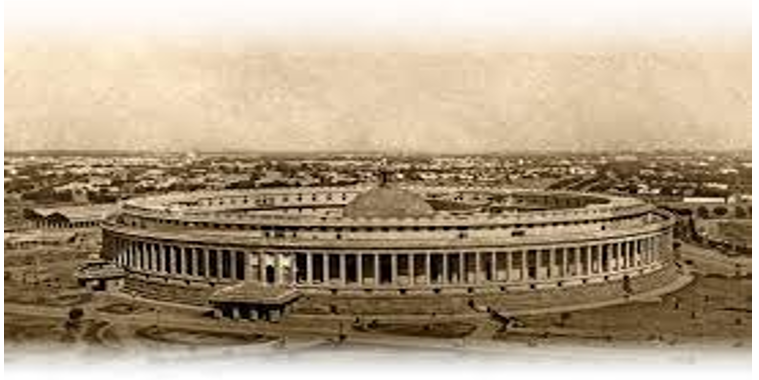The Constitution establishes a nation's, states, or social group's core ideas and rules, which define the government's powers and responsibilities, as well as guarantee certain rights to its citizens. Constitution is a written document that encapsulates a political, social and economic aspiration of Nation. It is a way of organizing a state or society and distributing sovereign power. This article provides a brief overview of the development of the Indian Constitution along with the ways in which such delicate topics can be covered with deeper understanding. Constitutional Development of India is an important topic for both Prelims and Mains stage of the IAS Examination.
Constitutional Development of India is basically the evolvement of the Constitution of India. GS SCORE is providing a detailed analysis on how to cover the Constitution of India that has evolved from the past to the present time. This article will help aspirants to briefly understand the Development of Indian Constitution starting from Regulating Act of 1773 till the time when the Constitution of India came into effect in 1950. The major focus area in this discussion is to provide a workable strategy mechanism to read and understand ‘Constitutional Development of India’ in lucid manner. Aspirants would find this article very helpful while preparing for the IAS Exam.
On a broader term, phases of the Constitutional Development of India is categorised into three dimensions for deeper understanding of the constitution;
|
Categorisation |
Perspective |
|
1. Historical Background of Indian Constitution |
a) What are the Historical background Associated with Different Acts/Policies Related to Constitution of India? |
|
2. Making of the Indian Constitution |
a) How Constitution was developed? b) What all were the hurdles in making of the Constitution? |
|
3. Overview of the Indian Constitution
|
a) What is the existing scenario of Indian Constitution functioning? b) What we have achieved in the last 70 years, is there anything that needs to be changed? |
Refer Syllabus:
- Having a thorough understanding of the UPSC syllabus is an extremely crucial step on the road to clear the UPSC Civil Services Examination. In order to clear the Civil Services Examination with flying colours, candidates should know the updated IAS syllabus with detail understanding.
- Having an understanding of Syllabus can help aspirants to prepare themselves for with deeper understanding on the topics. Take an example of “Constitutional Development of India”, aspirants should understand the meaning of words mentioned in the Syllabus of UPSC.
Analyse previous year Question Papers:
Aspirants should analyse at-least last five years of the question papers. Take an example of Prelims stage of the examination, aspirants should read;
- How the question of UPSC is framed related to the Constitution of India and how the choices are framed.
- Aspirants should also focus on what type of question UPSC likes to ask from the Indian Constitution topic.
|
Direct ( Tough) Question |
Statement Based (Analytical) Question |
|
Q. What was the exact constitutional status of India on 26th January, 1950? a) A Democratic Republic b) A Sovereign Democratic Republic c) A Sovereign Secular Democratic Republic d) A Sovereign Socialist Secular Democratic Republic |
Q. India adopted parliamentary democracy based on the British model, but how does Indian model differ from British model?
Select the correct answer using the code given below. a) 1 only b) 2 only c) Both 1 and 2 d) Neither 1 nor 2 |
Integrate & Interlink Topics:
Integrating and interlinking of the topics is the crucial step for clearing civil services examination. While doing this process, aspirants should keep in mind that they need to link multiple dimensions of current affairs to a static topic. For example take an example of ‘Constitutional Development’, aspirants should keep in mind that they need to link current affairs news with this static topic to understand and solve the questions.
Why?
In every country across the globe, people are expected to revere their Constitution and feel that it is their duty to know what is in it. It is a vital document, which is the basis of all laws enacted by any government in power. Understanding the Constitution can help aspirants to understand the polity of India.
How?
- It is vital to go through a national daily like The Hindu or The Indian Express and while reading these, pay special attention to news items and editorials that are either related to the Indian Constitution or the national as well as international political systems, in one way or the other.
- Polity questions in prelims can get tricky as in the first look of it, all options look similar and this may lead to confusion and ambiguity. Regular revisions and practising MCQ’s can help strengthen the basics and boost one’s confidence in the subject. Solving previous year prelims question papers can aid a candidate in understanding the nature of questions and prepare accordingly.
Source to Cover Topics:
Aspirants can refer to comprehensively and exhaustively made IAS Prelims Sampoorna Fact files by GS SCORE for developing deeper understanding on topics like “Constitutional Development of India”. For Basic understanding, aspirants can refer to the book suggestion given below;
- Class IX NCERT textbook – Democratic Politics-I
- Class X NCERT textbook – Democratic Politics-II
- Class XI NCERT textbook – Indian Constitution at work
- Indian Polity – M. Laxmikanth
- Introduction to the Constitution of India – D.D. Basu
- India Year Book
Last but not least, aspirants need to improve their performance on daily basis. Aspirants should have Skill of incorporating current affairs into your mains answers along with strategy to solve prelims questions. As you progress, you will find it easy to use facts and how various dimensions can be linked.
Related Articles



